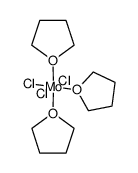Section 1: Product Identification
Chemical Name: Trichlorotris(tetrahydrofuran)molybdenum(III), min. 95%
CAS Registry Number: 31355-55-2
Formula: C12H24Cl3MoO3
EINECS Number: none
Chemical Family: metal halide
Synonym: Molybdenum trichloride, tris-tetrahydrofuran complex
Section 2: Composition and Information on Ingredients
Ingredient CAS Number Percent ACGIH (TWA) OSHA (PEL)
Title compound 31355-55-2 100% 10mg/m3 (as Mo) 15mg/m3 (as Mo)
Section 3: Hazards Identification
Corrosive to the upper respiratory tract, eyes and skin. Solid slowly hydrolyzes in contact with moisture
Emergency Overview:
releasing corrosive hydrogen chloride fumes. Tetrahydrofuran can cause drowsiness.
Primary Routes of Exposure: Ingestion, inhalation, skin, eyes.
Eye Contact: Dust and vapors cause burns to the eyes and blindness.
Skin Contact: Corrosive to skin. Contact can lead to redness, pain, blistering, ulceration and scar formation.
Inhalation of large amounts of dust results in acid burns to the respiratory tract, chemical pneumonitis and
Inhalation:
pulmonary edema.
Ingestion: Harmful if swallowed. Ingestion may cause damage to the mouth, throat and esophagus.
Inhalation of large amounts of dust would be extremely destructive to tissue of the mucous membranes and
Acute Health Affects:
upper respiratory tract, skin and eyes.
Chronic Health Affects: No information on long-term chronic effects.
NTP: No
IARC: No
OSHA: No
SECTION 4: First Aid Measures
Immediately flush the eyes with copious amounts of water for at least 10-15 minutes. A victim may need
Eye Exposure:
assistance in keeping their eye lids open. Get immediate medical attention.
Wash the affected area with water. Remove contaminated clothes if necessary. Seek medical assistance if
Skin Exposure:
irritation persists.
Remove the victim to fresh air. Closely monitor the victim for signs of respiratory problems, such as difficulty
Inhalation:
in breathing, coughing, wheezing, or pain. In such cases seek immediate medical assistance.
Seek medical attention immediately. Keep the victim calm. Give the victim water (only if conscious). Induce
Ingestion:
vomiting only if directed by medical personnel.
SECTION 5: Fire Fighting Measures
Flash Point: no data
Autoignition Temperature: no data
Explosion Limits: no data
Extinguishing Medium: carbon dioxide, dry powder or foam
If this product is involved in a fire, fire fighters should be equipped with a NIOSH approved positive pressure
Special Fire Fighting Procedures:
self-contained breathing apparatus and full protective clothing.
Hazardous Combustion and If involved in a fire this material may emit toxic chlorine and hydrochloric acid fumes.
Decomposion Products:
Unusual Fire or Explosion Hazards: No unususal fire or explosion hazards.
SECTION 6: Accidental Release Measures
Small spills can be mixed with powdered sodium bicarbonate, lime, or calcium carbonate and swept up.
Spill and Leak Procedures: Spillage in areas not adequately ventilated may require an evacuation of area. Emergency response teams
will require self-contained breathing apparatus.
SECTION 7: Handling and Storage
Store material in a tightly sealed container under an inert atmosphere of nitrogen or argon. Keep away from
Handling and Storage: moisture. If possible, handle the material in an efficient fume hood. Prolonged exposure to the atmosphere
may lead to degradation of the product.
SECTION 8: Exposure Controls and Personal Protection
Eye Protection: Always wear approved safety glasses when handling a chemical substance in the laboratory.
Skin Protection: Wear protective clothing and gloves.
Ventilation: Handle the material in an efficient fume hood.
If ventilation is not available a respirator should be worn. The use of respirators requires a Respirator
Respirator:
Protection Program to be in compliance with 29 CFR 1910.134.
Ventilation: Handle the material in an efficient fume hood.
Additional Protection: No additional protection required.
SECTION 9: Physical and Chemical Properties
Color and Form: light orange solid
Molecular Weight: 418.62
Melting Point: no data
Boiling Point: no data
Vapor Pressure: no data
Specific Gravity: no data
Odor: ethereal odor
Solubility in Water: reacts with water
SECTION 10: Stability and Reactivity
Stability: moisture sensitive
Hazardous Polymerization: no hazardous polymerization
Conditions to Avoid: contact with moisture
Incompatibility: water, alcohols, strong bases, and active metals.
Decomposition Products: molybdenum oxide, hydrogen chloride, carbon dioxide, carbon monoxide, organic fumes.
SECTION 11: Toxicological Information
RTECS Data: No information available in the RTECS files.
Carcinogenic Effects: No data
Mutagenic Effects: No data
Tetratogenic Effects: No data
SECTION 12: Ecological Information
Ecological Information: No information available
SECTION 13: Disposal Considerations
Disposal: Dispose of according to local, state and federal regulations.
SECTION 14: Transportation
Shipping Name (CFR): Corrosive solids, N.O.S.
Hazard Class (CFR): 8
Additional Hazard Class (CFR): NA
Packaging Group (CFR): II
UN ID Number (CFR): UN# 1759
Shipping Name (IATA): Corrosive solid, N.O.S.
Hazard Class (IATA): 8
Additional Hazard Class (IATA): NA
Packaging Group (IATA): II
UN ID Number (IATA): UN# 1759
SECTION 15: Regulatory Information
TSCA: Not listed in the TSCA inventory
SARA (Title 313): Title compound not listed
Second Ingredient: none
SECTION 16 - ADDITIONAL INFORMATION
N/A
